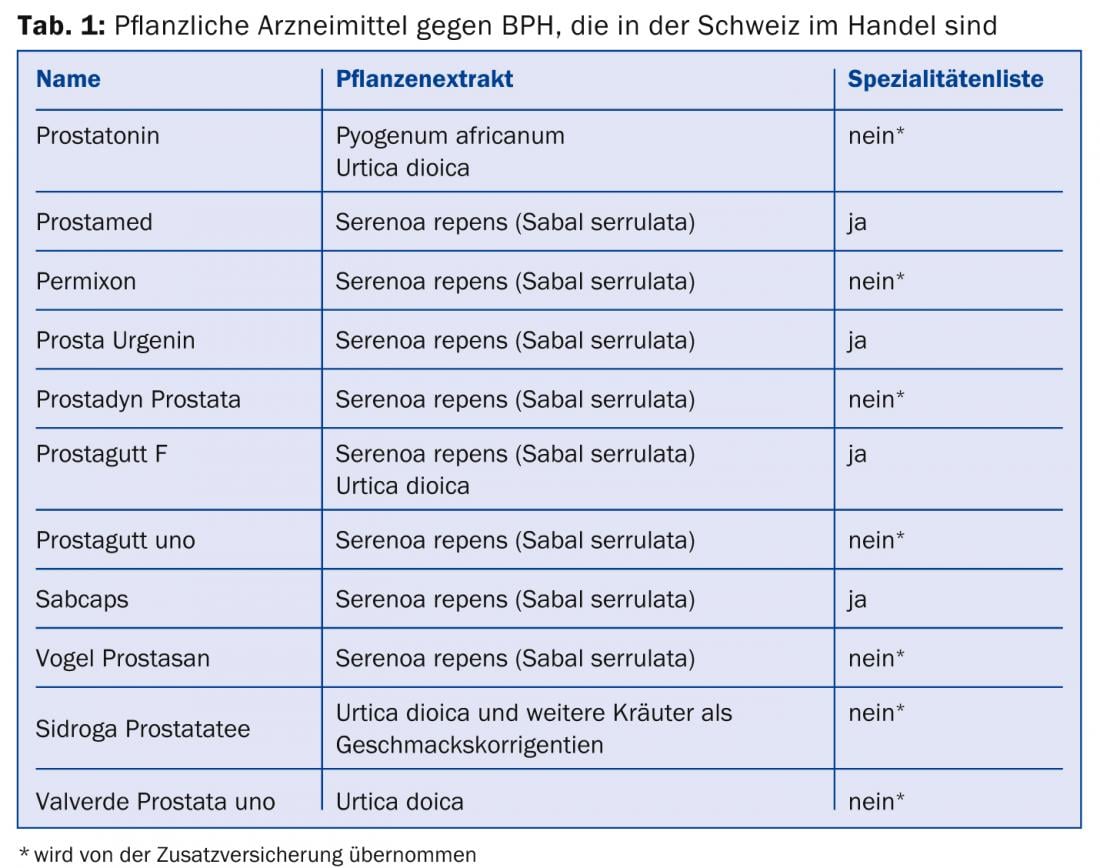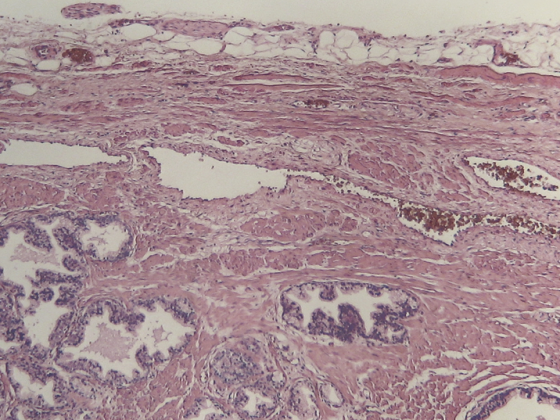For the treatment of Benign Prostatic Hyperplasia (BPH), various medicinal plants have been used in folk medicine. The focus of clinical research for the past 15 years or so has been on saw palmetto (Serenoa repens or Sabal serrulata), whose efficacy has been documented with numerous clinical trials. A negative study published in 2009 by the Cochrane Collaboration shows serious methodological deficiencies.
Folk medicine already recommended various herbal preparations against benign enlargement of the prostate (BPH). Chewing pumpkin seeds (Cucurbita pepo) and drinking willowherb tea (Epilobium species) are among the best known of these folk medicine treatments.
In addition, numerous herbal preparations from various medicinal plants (Table 1) such as Pyogenum africanum (African plum tree), Urtica doica (stinging nettle) and Serenoa repens (saw palmetto, former Latin name: Sabal serrulata) are also on the market in Switzerland.
No longer registered as medicines, i.e. only available as food supplements, are preparations with the already mentioned pumpkin seeds as well as from willowherb and from rye pollen.

Saw palmetto
For about 15 years, clinical research has focused on extracts from saw palmetto (Serenoa repens), a dwarf palm native to the southern United States. It has been used by the local Semiolans for generations to treat various ailments.
Free fatty acids and liposterols (beta-sitosterol) as well as carbohydrates, aromatic acids, anthranilic acid and syringoaldehyde have been isolated from the fruits of saw palmetto [1].
Pharmacologically, inhibition of 5-alpha-reductase as well as aromatase, inhibition of DHT binding to prostate androgen receptors [2–4] and stimulation of 3-alpha-hydroxisteroid-oxide reductase to degrade DHT [5,6] have been demonstrated.
Clinic
The list of clinical studies demonstrating the significant efficacy of various saw palmetto extracts is impressively long (a selection: [7–13]). All studies documented significant efficacy for the saw palmetto extracts. This involved both placebo-controlled and comparator studies. In these last, Serenoa repens was tested against tamsulosin [9,10] or also against finasteride [7], standard preparations of BPH treatment. These three studies showed that Serenoa repens was equal to the two standard synthetic preparations. The primary outcome variable was mostly defined as the I-IPSS [7–12], and in one case [13] served as a secondary outcome variable. The daily dose of the mostly well-defined saw palmetto extracts was consistently 320 mg/day, and the study duration varied from 18 [8] to 106 weeks [9] with a majority of 24 weeks.
Cochrane Review
Two Cochrane Reviews from 2000 and 2002 also came to the same conclusions, calling Serenoa repens significantly effective. However, another study in 2009 then came to a negative conclusion [14]. Although published by the Cochrane Collaboration, this study has a number of serious methodological flaws, draws incorrect conclusions from cited studies, and makes an incorrect inference when interpreting its own results. Well-known scientists have pointed out these errors [15,16]. From the perspective of unbiased science, this Cochrane Review is worthless.
Serenoa repens and Urtica dioica
In addition to the many clinically tested saw palmetto monopreparations, there is also a combination preparation consisting of extracts from saw palmetto and stinging nettle. This extract is known as PRO 160/120 and consists of 160 mg of saw palmetto extract and 120 mg of nettle extract. The two extracts act synergistically, nettle inhibits aromatase, which catalyzes the formation of estradiol and of androstenedione from testosterone [17].
The efficacy of this combination preparation has also been demonstrated with various clinical studies [18].
Facts
- Folk medicine recommends a number of medicinal plants for the treatment of BPH.
- Clinically proven herbal medicines contain extracts from saw palmetto (Serenoa repens or Sabal serrulata). Several of them are covered by basic insurance.
- There is also a clinically proven combination preparation of saw palmetto and nettle that is covered by supplementary insurance.
Literature:
- Degenring F, Weber M.: Serenoa-repens (Sabalserrulata) fruit extract. phytotherapy 2001; 4(1): 27-31.
- Bayne CW, et al: Serenoa repens (Permixon®): A 5-a-Reductase Types I and II Inhibitor – New Evidence in a Coculture Model of BPH. The Prostate 1999; 40: 232-241.
- Hagenlochner M, et al: Specific inhibition of 5-a-reductase by a new extract from Sabal serrulata. Akt Urol 1993; 24: 146-149.
- Weisser H, et al: Effects of the Sabal serrulata Extract IDS 89 and its Subfractions on 5-a-Reductase Activity in Human Benign Prostatic Hyperplasia. The Prostate 1996; 28: 300-306.
- Magdy El-Sheikh M, et al: The Effect of Permixon on Adrenergic Receptors. Acta Obstet Gynecol Scand 1998; 67: 397-399.
- Sultan Ch, et al: Inhibition of Androgen Metabolism and Binding by a Liposterolic Extract of “Serenoa Repens B” in Human Foreskin Fibroblasts. J Steroid Biochem 1984; 20(1): 515-519.
- Carraro, et al: Comparison of Phytotherapy (Permixon®) With Finasteride in the Treatment of Benign Prostate Hyperplasia: A Randomized International Study of 1 098 Patients. The Prostate 1996; 29: 231-240.
- Derakhshani P, et al: Influence of the International Prostate Symptom Score during therapy with saw palmetto fruit extract given once daily. Urologist B 1997; 37: 384-391.
- Debruyne F, et al: Comparison of a Phytotherapeutic Agent (Permixon) with an α-Blocker (Tamsulosin) in the Treatment of Benign Prostatic Hyperplasia: A 1-Year Randomized International Study. European Urology 2002; 41: 497-507.
- Debruyne F, et al: Evaluation of the Clinical Benefit of Permixon and Tamsulosin in Severe BPH Patients – PERMAL Study Subset Analysis. European Urology 2004; 45: 773-880.
- Sinescu I, et al: Long-Term Efficacy of Serenoa repens Treatment in Patients with Mild and Moderate Symptomatic Benign Prostatic Hyperplasia. Urol Int 2011 DOI: 101159/000322645.
- Guilianelli R, et al: Multicentre study on the efficacy and tolerability of an extract of Serenoa repens in patients with chronic benign prostate conditions associated with inflammation. Arch Ital Urol Androl 2012; 84(2): 94-98.
- Bertaccini A, et al.: Observational database serenoa repens (DOSSIER): overview, analysis and results. A multicentric SIUrO (Italian Society of Oncological Urology) project. Arch Ital Urol Androl 2012; 84(3):117-122.
- Tacklind J, et al: Serenoa repens for benign prostatic hyperplasia (Systematic Review), The Cochrane Library 2009; 2.
- Bilia AR, et al: Comment on cochraine review on Serenoa repens beo benign prostatic hyperplasia. ARS MEDICI thema Phytotherapy 2009; 9(4): 10-13.
- Frater-Schröder M: If a = b and a = c, then b = c. ARS MEDICI thema Phytotherapy 2009; 9(4): 2.
- Koch E, et al: Urologist B 1994; 34: 90-95.
- Popa G, et al: Symptomatic efficacy of a Sabal-Urtica combination preparation in the therapy of benign prostatic syndrome. MMW Fortsch Med Originalien 2005; 147(III): 103-108.
- Wilt T, et al: Serenoa repens for benign prostatic hyperplasia. Cochrane Database Syst Rev 2000; 2: CD001423.
- Wilt T, et al: Serenoa repensfor benign prostatic hyperplasia. Cochrane Database Syst Rev 2002; 3: CD001423.
HAUSARZT PRAXIS 2014; 9(5): 4-6











